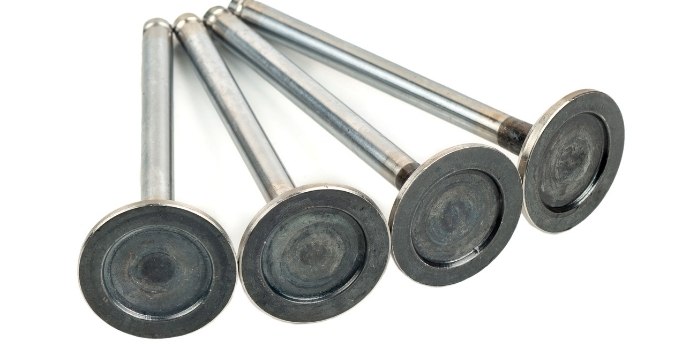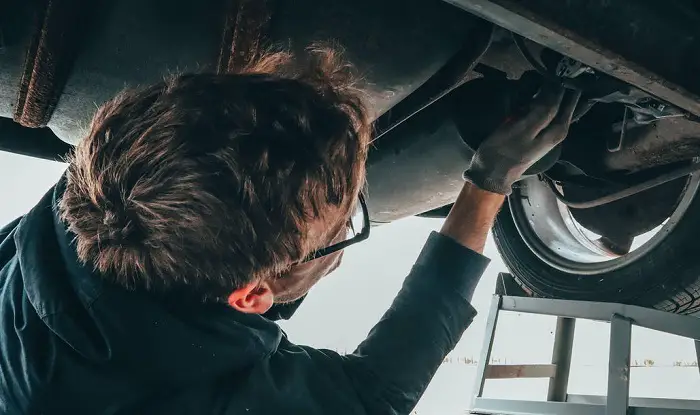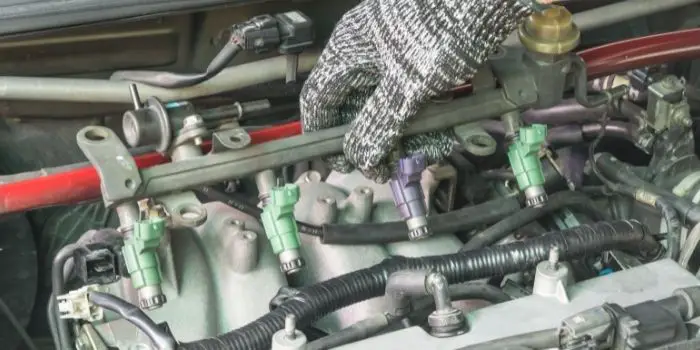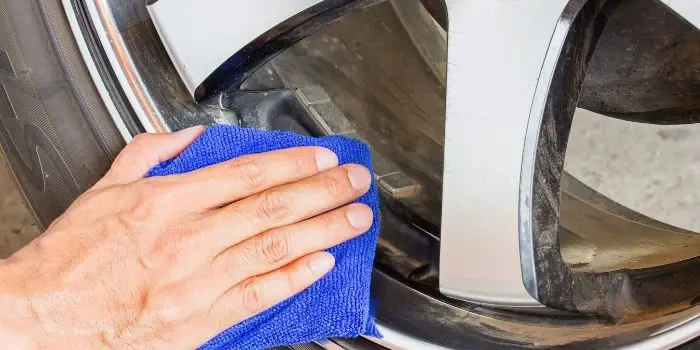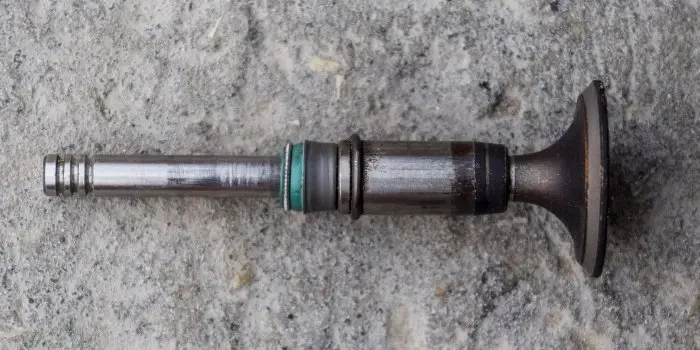
The engine in your automobile is made up of a series of valves that work together to let air into the cylinders and exhaust gases out.
When one of the valves becomes too hot, it might burn, resulting in poor cylinder sealing and a loss of compression.
If the engine has a burned valve, you’ll most likely notice one or more troubling symptoms that you should address right immediately.
Table of Contents
What do intake and exhaust valves mean?
The last component of the valve train system is the intake and exhaust valves.
They are constructed of hardened metal and must survive the high temperatures of the combustion chamber.
The passage of gases through the combustion chamber is controlled by intake and exhaust valves.
Air enters via intake valves and exits through exhaust valves.
They are designed with a slender stem that leads to a flatter face, and the intake valves are often bigger than the exhaust valves.
Each valve is only intended to move up and down, not side to side.
When a valve is closed, it fits securely on the valve seat, preventing air passage.
When it is open, however, it separates from the valve seat, allowing air to flow through.
Many contemporary engines have two intake and two exhaust valves per cylinder.
What is the significance of intake and exhaust valves?
For an internal combustion engine to function, four events must occur. These are referred to as strokes.
The intake stroke is the first of two strokes.
By opening the intake valves during the intake stroke, an fuel/air mixture is pulled into the combustion chamber (with direct injection engines, the fuel is injected after the air has been drawn in).
The compression stroke comes next.
When the intake and exhaust valves shut, the fuel/air combination is trapped in the combustion chamber.
The piston is now pushed upward, compressing the fuel/air combination and making it extremely flammable.
The power stroke is the following stroke.
A spark plug ignites the compressed fuel/air combination. The ignited mixture quickly expands while the exhaust and intake valves stay closed, driving the piston back down into the cylinder.
This, in turn, rotates the crankshaft, which finally turns the vehicle’s wheels through the power train.
The exhaust stroke is the last. During the exhaust stroke, the piston will start to rise again, forcing the spent mixture through the now-open exhaust valve.
The exhaust valve will shut when the exhaust gases have exited the cylinder, and the intake stroke will begin again.
When traveling at motorway speeds, this complete cycle happens almost 1300 times each minute.
What could go wrong with intake and exhaust valves?
Although valves may fail for a variety of causes, bent valves and burned valves are the most prevalent.
What exactly is a burned valve?
One or more camshafts of a combustion engine open and shut a sequence of valves.
The valves are housed in the cylinder heads of the engine and are kept in place by guides.
Depending on the engine’s design, each cylinder normally contains 2 or 4 valves.
Intake and exhaust valves are the two kinds of valves. Intake valves let air into the engine’s cylinder, while exhaust valves let exhaust gases.
A burned valve is just a valve that has been destroyed by high heat. The high heat often causes the valve’s margins to burn.
Thermal shock may happen in rare situations, causing a part of the valve to shatter or break.
The exhaust valve is exposed to very hot gases continually. On top of that, the exhaust valve is not helped by cold air going inside the engine.
As a consequence of these variables, exhaust valves work hot and are more likely to get damaged than the intake valve.
What is the cause of valves getting burnt?
Any problem that generates too much heat in the cylinder head might burn the valve.
The following are a few of the reasons for a burned valve:
Valve is not seated properly or is stuck open
Hot gases may slip through a valve that does not seat correctly in the cylinder head, which burns it.
Wrong lash adjustment, wear and tear on the seat and valve, inappropriate valve erosion, and machine work are all common reasons for faulty valve seating.
Carbon deposit increase, weak valve springs, and wrong valve clearance may all result in the valve staying open, preventing it from correctly sitting.
Excessive Operating Temperatures
This might result in burned valves. Cooling system issues, such as less coolant level and damaged water pump, for example, might make the engine hotter than usual while running, resulting in burned valves.
Localized high-temperature issues (for example, clogged coolant pipes or a damaged head gasket) might have the same impact.
Engine performance issues
Burned valves may also occur as a consequence of any engine performance issue that produces an increment in combustion temperature.
Burnt valves, for example, maybe caused by detonation, a low air-fuel ratio, and pre-ignition.
Symptoms of a burned exhaust valve
Do you believe you may have a burned valve?
You may be correct if your car exhibits the following symptoms.
Because other faults may exhibit the same indications as a burned valve, you should conduct a complete evaluation of the automobile before making any repairs.
Misfiring and rough running
To function properly, a fuel combustion engine requires three essential ingredients: a precise fuel/air combination, correct spark, and enough compression.
A cylinder with a burned valve will not seal correctly, resulting in compression loss. As a consequence, the vehicle’s engine will begin to misfire and run rough.
Check Engine Light That Is Illuminated
The engine computer in your automobile, also known as the powertrain control module, monitors for abnormalities that might lead to an increase in vehicle emissions, like a misfire caused by a leak of the exhaust valve.
If the module identifies such a malfunction, it illuminates the check engine light and records a diagnostic troubles code (DTC) in the memory.
What should be done if damaged valves are suspected?
When broken valves are suspected, the first step in diagnosis is a leak-down test.
The engine is rotated throughout this test until the top dead center of the presently tested cylinder is reached.
At this point, the intake and exhaust valves will be closed.
Through the spark plug hole, compressed air is fed into the cylinder.
A leak-down gauge is then used to determine the cylinder’s ability to maintain pressure.
The valves are leaking if considerable leakage is discovered from the car’s throttle body or exhaust.
In rare circumstances, a borescope placed into the cylinder may be used to check the valves.
The valve cover may also need to be removed to check the valve train. If all else fails, the cylinder head may have to be removed to inspect the valves.
Your technician will be able to identify and correct the problem. All you have to do is notify them about the problems you’re having with the automobile.
They may then conduct a full examination, identify the issue, and make any required repairs.
What is the cost of repairing burned valves?
Unfortunately, restoring burned valves is a difficult task. Valve replacement is a major task that necessitates engine disassembly.
Because this is such a demanding process, the cost of valve repairs might exceed $5,500 just in labor. After diagnosis, this repair might take 40+ hours to perform.
This estimate excludes the cost of components, which will raise the overall cost of repairs even further.
Sometimes, rather than replacing the valves, they only need to be adjusted. To maintain your engine running smoothly, adjust the gap between the camshaft and the valve.
Engine valve modifications are much less expensive than engine valve replacements. The cost of changing your engine valves might vary, but it is usually in the hundreds of dollars.
FAQs
Q. How to Look for Burned Valves
A specialist will normally run compression tests, leak down tests, or both to look for a burned valve. The most precise procedure is generally a leak-down test.
A liquid leak down test may be performed if the cylinder head is removed and you want to evaluate if a suspicious valve is burned and leaking.
Q. How to Repair a Burned Valve
You can’t repair a burned valve; it must replace it.
To prevent recurrence failure, you should also address whatever caused the valve to burn in the first place.
Q. Is it safe to drive with a blown valve?
You shouldn’t drive with burned valve since it may cause extra harm to the car.
A component of the valve, for example, might fall off and cause damage to other elements of the engine.
A misfire (produced by a burned valve) might also damage another part such as the catalytic converter.

Based in Orem (Utah) John Paterson graduated from Utah Valley University and has begun writing in 2009. He has a large wealth of experience in writing articles related to cars, automotive repair, wheels, cleaning/maintenance, and much more. He has also written instructional articles in a similar niche for a few online publications as well. Currently, he works as a mechanic in his personal garage shop where he loves serving his countrymen from his heart.

